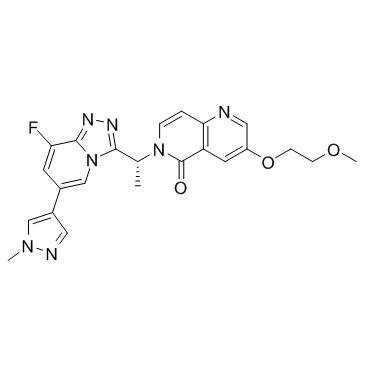
AMG-337
CAS No. 1173699-31-4
AMG-337( AMG337 | AMG 337 )
Catalog No. M10584 CAS No. 1173699-31-4
AMG-337 is a potent and selective inhibitor of MET with biochemical IC50 of 1 nM; inhibits of HGF-mediated MET phosphorylation in PC3 cells.
Purity : >98% (HPLC)
 COA
COA
 Datasheet
Datasheet
 HNMR
HNMR
 HPLC
HPLC
 MSDS
MSDS
 Handing Instructions
Handing Instructions
| Size | Price / USD | Stock | Quantity |
| 2MG | 43 | In Stock |


|
| 5MG | 69 | In Stock |


|
| 10MG | 113 | In Stock |


|
| 25MG | 186 | In Stock |


|
| 50MG | 332 | In Stock |


|
| 100MG | 494 | In Stock |


|
| 200MG | 709 | In Stock |


|
| 500MG | Get Quote | In Stock |


|
| 1G | Get Quote | In Stock |


|
Biological Information
-
Product NameAMG-337
-
NoteResearch use only, not for human use.
-
Brief DescriptionAMG-337 is a potent and selective inhibitor of MET with biochemical IC50 of 1 nM; inhibits of HGF-mediated MET phosphorylation in PC3 cells.
-
DescriptionAMG-337 is a potent and selective inhibitor of MET with biochemical IC50 of 1 nM; inhibits of HGF-mediated MET phosphorylation in PC3 cells; shows desirable preclinical pharmacokinetics, significant inhibition of MET phosphorylation in mice, and robust tumor growth inhibition in a MET-dependent mouse efficacy model.Gastric Cancer Phase 2 Clinical(In Vitro):AMG 337 (0-3 μM; 72 h) inhibits proliferation in MET-dependent cancer cell lines.AMG 337 (0-300 nM; 0-24 h; MKN-45, SNU-620, and SNU-5 cells) inhibits signaling through the PI3K and MAPK pathways in MET-amplified gastric cancer cell lines, resulting in an inhibition of MET-dependent cell proliferation and induction of apoptosis.(In Vivo):AMG 337 (0-30 mg/kg; p.o.; daily, for 28 d) inhibits MET signaling in tumor xenografts and inhibits tumor growth in MET-dependent tumor xenograft models.AMG 337 (0-3 mg/kg; p.o.; once, for 3 or 24 h) is associated with increased necrosis in the MET-dependent SNU-620 tumor xenograft model.
-
In VitroAMG 337 (0-3 μM; 72 h) inhibits proliferation in MET-dependent cancer cell lines.AMG 337 (0-300 nM; 0-24 h; MKN-45, SNU-620, and SNU-5 cells) inhibits signaling through the PI3K and MAPK pathways in MET-amplified gastric cancer cell lines, resulting in an inhibition of MET-dependent cell proliferation and induction of apoptosis. Apoptosis Analysis Cell Line:MKN-45 and SNU-620 cells Concentration:0, 3, 10, 30, 100 and 300 nM Incubation Time:24 hours Result:Increased the number of cells undergoing apoptosis.Cell Cycle Analysis Cell Line:MKN-45 and SNU-620 cells Concentration:0, 3, 10, 30, 100 and 300 nM Incubation Time:24 hours Result:Increased in a dose-dependent in cells in the G1 phase and with concurrent reduction of cells in S-phase.Western Blot Analysis Cell Line:MKN-45, SNU-620, and SNU-5 cells Concentration:100 nM Incubation Time:2 hours Result:Inhibited MET phosphorylation and phosphorylation of downstream effectors.Western Blot Analysis Cell Line:MKN-45, SNU-620, and SNU-5 cells Concentration:100 nM Incubation Time:24 hours Result:Induced PARP and caspase-3 cleavage in SNU-620 and SNU-5 cells.
-
In VivoAMG 337 (0-30 mg/kg; p.o.; daily, for 28 d) inhibits MET signaling in tumor xenografts and inhibits tumor growth in MET-dependent tumor xenograft models.AMG 337 (0-3 mg/kg; p.o.; once, for 3 or 24 h) is associated with increased necrosis in the MET-dependent SNU-620 tumor xenograft model. Animal Model:Female CD1 nu/nu mice bearing SNU-620, SNU-5, or U-87 MG xenografts Dosage:0, 0.3, and 1 mg/kg (SNU-620 xenograft); 0, 0.3, 1, 3, and 10 mg/kg (SNU-5 xenograft); 0, 3, 10 and 30 mg/kg (U-87 xenograft)Administration:Oral administration; daily, for 28 days Result:Inhibited tumor growth in MET-dependent tumor xenograft models.Animal Model:Female CD1 nu/nu mice bearing SNU-620, SNU-5, or U-87 MG xenograftsDosage:0.1, 0.5, 0.75, 1, 2, and 3 mg/kg Administration:Oral administration; once, for 3 hours Result:Inhibited Gab-1 phosphorylation in a dose-dependent manner.Animal Model:Female CD1 nu/nu mice with SNU-620 xenograft model (6-11 weeks of age; 20-26 g)Dosage:0, 0.3, 1, and 3 mg/kg Administration:Oral administration; once, for 3 or 24 hours Result:Increased immunohistochemical staining with anti-caspase-3 antibody and decreased immunohistochemical staining with anti-BrdU antibody.
-
SynonymsAMG337 | AMG 337
-
PathwayAngiogenesis
-
Targetc-Met/HGFR
-
RecptorMet|Met(H1094R)|Met(M1250T)|Met(V1092I)|Met(Y1230H)
-
Research AreaCancer
-
IndicationGastric Cancer
Chemical Information
-
CAS Number1173699-31-4
-
Formula Weight463.4643
-
Molecular FormulaC23H22FN7O3
-
Purity>98% (HPLC)
-
SolubilityDMSO: ≥ 30 mg/mL
-
SMILESO=C1C2=C(N=CC(OCCOC)=C2)C=CN1[C@@H](C3=NN=C4C(F)=CC(C5=CN(C)N=C5)=CN43)C
-
Chemical Name1,6-Naphthyridin-5(6H)-one, 6-[(1R)-1-[8-fluoro-6-(1-methyl-1H-pyrazol-4-yl)-1,2,4-triazolo[4,3-a]pyridin-3-yl]ethyl]-3-(2-methoxyethoxy)-
Shipping & Storage Information
-
Storage(-20℃)
-
ShippingWith Ice Pack
-
Stability≥ 2 years
Reference
1. Boezio AA, et al. J Med Chem. 2016 Mar 24;59(6):2328-42.
2. Hughes PE, et al. Mol Cancer Ther. 2016 Jul;15(7):1568-79.
3. Du Z, et al. Mol Cancer Ther. 2016 Jun;15(6):1227-37.
molnova catalog



related products
-
Emibetuzumab
Emibetuzumab is a potent humanized bivalent MET antibody (IgG4 type). Emibetuzumab has antitumor activity, inhibition of HGF-dependent and independent MET pathway activation and tumor growth, and can be used to study advanced castration-resistant prostate cancer.
-
Hepln-13
Hepln-13 is a hepsin inhibitor that acts by hindering prostate cancer bone metastasis.
-
MET inhibitor Compou...
A novel potent, selective orally bioavailable MET tyrosine kinase inhibitor with IC50 of <1 nM and 12 nM for unphosphorylated and phosphorylaed MET, respectively.



 Cart
Cart
 sales@molnova.com
sales@molnova.com


